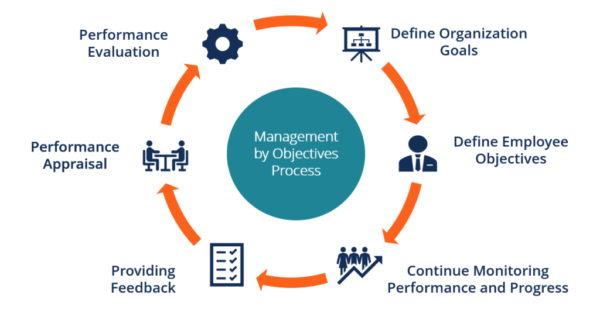Management by Objectives (MBOs) breaks down big picture goals into manageable chunks for employees and provides a tool for measuring performance against these goals.
The concept of MBOs was first popularized by Peter Drucker in the book, The Practice of Management, but has been expanded on over the years and is in use by most companies in some form today, although other names may call them.
The Benefits of Management by Objectives (MBOs)
MBOs help keep teams on track by maintaining focus on the goals the company needs to accomplish to be successful. Once the objectives are identified, many companies incentivize their employees to achieve these goals by tying raises or bonuses to goal accomplishment. When everyone knows what’s expected, how they will be assessed, and have a personal stake in the outcome, productivity typically increases as does engagement.
MBOs help employees understand how their role fits within the organization. It can tie personal contributions to overall goals and offer a scorecard on whether they are meeting goals or falling short.
Managers can also use MBOs to help employees acquire the skills they need to advance in the organization or their careers.

Image Source: Corporate Finance Institute
Strategies for Setting Management by Objectives
Creating effective MBOs follows a 6-step process:
1. Define Organizational Goals
The first step in developing MBOs is to determine which goals are worth achieving. There are many goals companies may have, but some are more important than others. Find the ones that will move companies forward most directly.
2. Create Employee MBOs
From these big picture goals, you can create the specific steps it will take to achieve them. Break down the goal into smaller objectives that will contribute to meeting the goal. MBOs might pertain to group efforts or individual contributions.
3. Performance Monitoring
To be effective, MBOs have to be communicated and reinforced. This makes setting up internal controls for measurement and comparing performance with MBOs.
4. Providing Feedback
Continuous feedback on performance and goal attainment is necessary. Managers should monitor progress against goals at critical milestones and remind employees about their MBOs and their performance against the goals regularly. This keeps MBOs front and center while also giving managers time to provide additional training, coaching, or course correction.
5. Performance Appraisal
Although regular feedback helps employees stay on track with MBOs, there should be scheduled performance appraisals. For example, if MBOs are set on an annual basis, quarterly performance appraisals could be set up to evaluate progress.
6. Performance Evaluation
A formal evaluation should take place to measure whether employees met their MBOs. These typically occur at the end of the established timeline or annually. This provides an opportunity for rewarding those that met their MBOs or showing where improvement is needed.
How to Create Effective Management by Objectives?
By setting objectives, managers can give employees guidance on how to use their time effectively and help them focus on the goals the company needs to succeed. To be effective, MBOs have to be attainable and specific.
Many companies using MBOs create them by using the SMART goal strategy.
- Specific
- Measurable
- Attainable
- Relevant
- Time-based
Specific
Goals must be specific. The narrower goal you set, the more likely they are to be achieved.
Measurable
Goals also have to be measurable. Otherwise, how will employees know when they’ve reached them?
Achievable
If goals feel unattainable for employees, MBOs can hurt morale and productivity. It’s OK to stretch, but they need to be something that can be realistically achieved.
Relevant
Goals should align with an organization’s values and long-term goals. Employees need to understand how achieving the goals helps the organization and themselves.
Time-based
Goals need to have established timetables for completion. Managers may also want to add interim goals or checkpoints for progress.
Examples of Management by Objectives (MBOs)
MBOs need to check each of the boxes. Here are a few examples:
POOR: Increase sales productivity
BETTER: Acquire three new customers each month
POOR: Improve profit margin
BETTER: Increase average sales price per unit by 5%
POOR: Improve sales skills
BETTER: Complete 2 sales training sessions quarterly
In setting MBOs, you may find that you need to start with a broad-based goal and continue to break it down into incremental steps. To grow sales, you may need to close more deals. Before you can do that, however, you need to get more qualified leads into your sales funnel. To do that, you need to do more outreach and activity.
Start with the significant results (get more customers) and work backward. Can you quantify how many presentations it takes to get to a close? How many qualified leads does it take to get to a meeting? How many contacts does it take to develop a lead?
By analyzing past performance, you can determine what needs to happen at each step to create the result you want and then put them into action.
Other Classic Frameworks:
If you liked Management by Objectives, please read about other classic frameworks by other famous authors and management thinkers.

